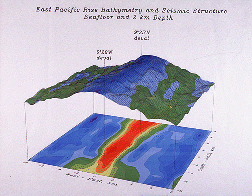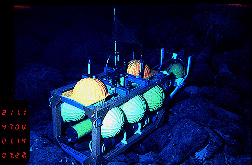![]()
 Mid-ocean ridge research is at the forefront of systems-oriented studies
in the earth sciences. Mid-ocean ridges are the primary sites for transferring
energy and material from the Earth's interior to its surface. The global
heat budget is dominated by the formation, cooling, and eventual subduction
of oceanic lithosphere. The bulk of the planet's magmatic budget is accounted
for by the generation of 20 cubic kilometers of new oceanic crust per year.
Hydrothermal circulation that accompanies magmatism facilitates chemical
exchange between the solid earth and the ocean and plays a pivotal role
in supporting the unique biological communities that congregate along ridge
axes. To understand the dynamics of mid-ocean ridges and the system as
a whole we need to investigate interacting processes, such as magmatic,
tectonic, and hydrothermal activity, over a range of spatial and temporal
dimensions.
Mid-ocean ridge research is at the forefront of systems-oriented studies
in the earth sciences. Mid-ocean ridges are the primary sites for transferring
energy and material from the Earth's interior to its surface. The global
heat budget is dominated by the formation, cooling, and eventual subduction
of oceanic lithosphere. The bulk of the planet's magmatic budget is accounted
for by the generation of 20 cubic kilometers of new oceanic crust per year.
Hydrothermal circulation that accompanies magmatism facilitates chemical
exchange between the solid earth and the ocean and plays a pivotal role
in supporting the unique biological communities that congregate along ridge
axes. To understand the dynamics of mid-ocean ridges and the system as
a whole we need to investigate interacting processes, such as magmatic,
tectonic, and hydrothermal activity, over a range of spatial and temporal
dimensions.
![]()
 The purpose of my research is to place quantitative constraints on the
physical structure of mid-ocean ridges and to use these constraints to
infer the nature of magmatic, tectonic, and hydrothermal phenomena. To
do so I use modern seismic methods, many of which I develop, to map internal
structure on scales ranging from hundreds of meters to hundreds of kilometers.
By mapping features over a range of scales we may determine, for example,
the volume of upper mantle involved in decompression melting beneath ridges,
the nature of the transition from broad scale upwelling (hundreds of kilometers)
to the accretion of new crustal material within a kilometer-wide neovolcanic
zone, the size and shape of axial magma chambers responsible for the formation
of oceanic crust, and the spatial connections between hydrothermal cells
and their crustal heat sources. Because mid-ocean ridge characteristics
vary dramatically with magma supply (which loosely parallels spreading
rate), my studies are conducted at a variety of geographic locations, including
the slow-spreading Mid-Atlantic Ridge, the fast-spreading East Pacific
Rise, sub-aerial sections of the ridge in Iceland, and exposed sections
of oceanic crust and mantle found in ophiolites (Oman). Comparative studies
of ridge segments in different stages of their evolution also assists in
inferring temporal variability of long-lived geologic phenomena. The tomographic
image of the East Pacific Rise at the left shows anomalous compressional
wave velocities associated with axial magmatism.
The purpose of my research is to place quantitative constraints on the
physical structure of mid-ocean ridges and to use these constraints to
infer the nature of magmatic, tectonic, and hydrothermal phenomena. To
do so I use modern seismic methods, many of which I develop, to map internal
structure on scales ranging from hundreds of meters to hundreds of kilometers.
By mapping features over a range of scales we may determine, for example,
the volume of upper mantle involved in decompression melting beneath ridges,
the nature of the transition from broad scale upwelling (hundreds of kilometers)
to the accretion of new crustal material within a kilometer-wide neovolcanic
zone, the size and shape of axial magma chambers responsible for the formation
of oceanic crust, and the spatial connections between hydrothermal cells
and their crustal heat sources. Because mid-ocean ridge characteristics
vary dramatically with magma supply (which loosely parallels spreading
rate), my studies are conducted at a variety of geographic locations, including
the slow-spreading Mid-Atlantic Ridge, the fast-spreading East Pacific
Rise, sub-aerial sections of the ridge in Iceland, and exposed sections
of oceanic crust and mantle found in ophiolites (Oman). Comparative studies
of ridge segments in different stages of their evolution also assists in
inferring temporal variability of long-lived geologic phenomena. The tomographic
image of the East Pacific Rise at the left shows anomalous compressional
wave velocities associated with axial magmatism.

Seismological studies of mid-ocean ridges are entering a new era due
to technological advances in ocean bottom instrumentation. In the past,
ocean bottom seismometers were limited to a deployment duration measured
in weeks. With advances in computer hardware and instrument design, a new
generation of instruments will achieve deployment times measured in months
and years. These advances are opening up new avenues for seismologists,
including long-term monitoring of seismicity and passive teleseismic imaging
of deep earth structure. Because my studies have pioneered the use of ocean
bottom seismic arrays to characterize axial seismicity and to image three-dimensional
physical structure, I am particularly excited by these developments.
![]()